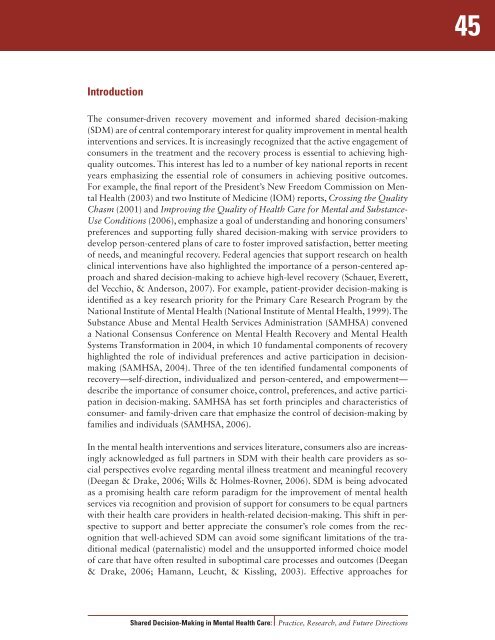Shared Decision-Making in Mental Health Care - SAMHSA Store ...
Shared Decision-Making in Mental Health Care - SAMHSA Store ...
Shared Decision-Making in Mental Health Care - SAMHSA Store ...
Create successful ePaper yourself
Turn your PDF publications into a flip-book with our unique Google optimized e-Paper software.
45IntroductionThe consumer-driven recovery movement and <strong>in</strong>formed shared decision-mak<strong>in</strong>g(SDM) are of central contemporary <strong>in</strong>terest for quality improvement <strong>in</strong> mental health<strong>in</strong>terventions and services. It is <strong>in</strong>creas<strong>in</strong>gly recognized that the active engagement ofconsumers <strong>in</strong> the treatment and the recovery process is essential to achiev<strong>in</strong>g highqualityoutcomes. This <strong>in</strong>terest has led to a number of key national reports <strong>in</strong> recentyears emphasiz<strong>in</strong>g the essential role of consumers <strong>in</strong> achiev<strong>in</strong>g positive outcomes.For example, the f<strong>in</strong>al report of the President’s New Freedom Commission on <strong>Mental</strong><strong>Health</strong> (2003) and two Institute of Medic<strong>in</strong>e (IOM) reports, Cross<strong>in</strong>g the QualityChasm (2001) and Improv<strong>in</strong>g the Quality of <strong>Health</strong> <strong>Care</strong> for <strong>Mental</strong> and Substance-Use Conditions (2006), emphasize a goal of understand<strong>in</strong>g and honor<strong>in</strong>g consumers’preferences and support<strong>in</strong>g fully shared decision-mak<strong>in</strong>g with service providers todevelop person-centered plans of care to foster improved satisfaction, better meet<strong>in</strong>gof needs, and mean<strong>in</strong>gful recovery. Federal agencies that support research on healthcl<strong>in</strong>ical <strong>in</strong>terventions have also highlighted the importance of a person-centered approachand shared decision-mak<strong>in</strong>g to achieve high-level recovery (Schauer, Everett,del Vecchio, & Anderson, 2007). For example, patient-provider decision-mak<strong>in</strong>g isidentified as a key research priority for the Primary <strong>Care</strong> Research Program by theNational Institute of <strong>Mental</strong> <strong>Health</strong> (National Institute of <strong>Mental</strong> <strong>Health</strong>, 1999). TheSubstance Abuse and <strong>Mental</strong> <strong>Health</strong> Services Adm<strong>in</strong>istration (<strong>SAMHSA</strong>) conveneda National Consensus Conference on <strong>Mental</strong> <strong>Health</strong> Recovery and <strong>Mental</strong> <strong>Health</strong>Systems Transformation <strong>in</strong> 2004, <strong>in</strong> which 10 fundamental components of recoveryhighlighted the role of <strong>in</strong>dividual preferences and active participation <strong>in</strong> decisionmak<strong>in</strong>g(<strong>SAMHSA</strong>, 2004). Three of the ten identified fundamental components ofrecovery—self-direction, <strong>in</strong>dividualized and person-centered, and empowerment—describe the importance of consumer choice, control, preferences, and active participation<strong>in</strong> decision-mak<strong>in</strong>g. <strong>SAMHSA</strong> has set forth pr<strong>in</strong>ciples and characteristics ofconsumer- and family-driven care that emphasize the control of decision-mak<strong>in</strong>g byfamilies and <strong>in</strong>dividuals (<strong>SAMHSA</strong>, 2006).In the mental health <strong>in</strong>terventions and services literature, consumers also are <strong>in</strong>creas<strong>in</strong>glyacknowledged as full partners <strong>in</strong> SDM with their health care providers as socialperspectives evolve regard<strong>in</strong>g mental illness treatment and mean<strong>in</strong>gful recovery(Deegan & Drake, 2006; Wills & Holmes-Rovner, 2006). SDM is be<strong>in</strong>g advocatedas a promis<strong>in</strong>g health care reform paradigm for the improvement of mental healthservices via recognition and provision of support for consumers to be equal partnerswith their health care providers <strong>in</strong> health-related decision-mak<strong>in</strong>g. This shift <strong>in</strong> perspectiveto support and better appreciate the consumer’s role comes from the recognitionthat well-achieved SDM can avoid some significant limitations of the traditionalmedical (paternalistic) model and the unsupported <strong>in</strong>formed choice modelof care that have often resulted <strong>in</strong> suboptimal care processes and outcomes (Deegan& Drake, 2006; Hamann, Leucht, & Kissl<strong>in</strong>g, 2003). Effective approaches for<strong>Shared</strong> <strong>Decision</strong>-<strong>Mak<strong>in</strong>g</strong> <strong>in</strong> <strong>Mental</strong> <strong>Health</strong> <strong>Care</strong>:Practice, Research, and Future Directions
















